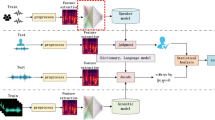Abstract
In human-based visual and auditory forensic speaker recognition or comparison, experts make judgments on whether or not two speech samples are from the same speaker. They compare specific parts of the same phoneme where the speaker's characteristics appear. Inspired by this process, we propose a Same Speaker Identification Deep Neural Network (SSI-DNN) that identifies whether or not two speech samples are uttered by the same speaker by focusing on the same phonemes, which have very short durations. The architecture of the proposed SSI-DNN is based on ResNet, with the input extended to be two speech samples, and the output is the identification result. Because the proposed method does not use speaker embedding or speaker models, it can be trained on a small number of utterances for each speaker. To evaluate the verification performance, we conducted speaker verification experiments for five Japanese single vowels, which are 0.12 s each, and a short phrase “oi,” which means “hey,” in a speech database for the forensic speaker recognition constructed by the National Research Institute of Police Science in Japan. The experimental results showed that when two speech samples were uttered 30 min apart, the equal error rate (EER) for single vowels was 7.4%, 1.2% for the five-vowel score combination, and 4.0% for “oi.” With about a three-month interval, the EER was 12.8% for single vowels, 4.2% for the five-vowel score combination, and 8.1% for “oi.”
Access this chapter
Tax calculation will be finalised at checkout
Purchases are for personal use only
Similar content being viewed by others
References
Yokoyama, M.: Elderly victimization in aging Japan. In: Kratcoski, P., Edelbacher, M. (eds.) Perspectives on Elderly Crime and Victimization, pp. 141–160. Springer, Cham (2018)
Amino, K., Osanai, T., Kamada, T., Makinae, H., Arai, T.: Historical and procedural overview of forensic speaker recognition as a science. In: Neustein, A., Patil, H. (eds.) Forensic Speaker Recognition, pp. 3–20. Springer, New York, NY (2012)
Zeinali, H., Lee, K.A., Alam, J., Burget, L.: Short-duration Speaker Verification (SdSV) Challenge 2021: The Challenge Evaluation Plan. arXiv:1912.06311v3 (2021)
Tawara, N., Ogawa, A., Iwata, T., Delcroix, M., Ogawa, T.: Frame-level phoneme-invariant speaker embedding for text-independent speaker recognition on extremely short utterances. In: 2020 IEEE International Conference on Acoustics, Speech and Signal Processing (ICASSP), pp. 6799–6803, May (2020)
Gusev, A., Vinogradova, A., Novoselov, S., Astapov, S.: SdSVC Challenge 2021: Tips and Tricks to Boost the Short-duration Speaker Verification System Performance. In: Interspeech 2021, pp. 2307–2311, August (2021)
Jie, Y., Shengyu, Y., Yiqian, P., Wei, C.: SdSVC Challenge 2021: The Sogou system for short-duration speaker verification challenge 2021. In: Interspeech 2021, pp. 2327–2331, August (2021)
Kaiming, H., Xiangyu, Z., Shaoqing, R., Jian, S.: Deep residual learning for image recognition. In: Proceedings of the IEEE Conference on Computer Vision and Pattern Recognition, pp. 770–778 (2016)
Lin, Q., Cai, W., Yang, L., Wang, J., Zhang, J., Li, M.: DIHARD II is still hard: experimental results and discussions from the DKU-LENOVO Team. In: Odyssey 2020 the Speaker and Language Recognition Workshop, pp. 102–109, November (2020)
Makinae, H., Osanai, T., Kamada, T., Tanimoto, M.: Construction and preliminary analysis of a large-scale bone-conducted speech database. IEICE Technical Report SP, vol. 107, pp. 97–102, July (2007)
Acknowledgements
This research was supported by JSPS KAKENHI Grant Number 18H01671, 18H03260, 19K11975, 20K11860, and the Kayamori Foundation of Informational Science.
Author information
Authors and Affiliations
Corresponding author
Editor information
Editors and Affiliations
Rights and permissions
Copyright information
© 2022 The Author(s), under exclusive license to Springer Nature Singapore Pte Ltd.
About this paper
Cite this paper
Takamizawa, M., Tsuge, S., Horiuchi, Y., Kuroiwa, S. (2022). Same Speaker Identification with Deep Learning and Application to Text-Dependent Speaker Verification. In: Zimmermann, A., Howlett, R.J., Jain, L.C. (eds) Human Centred Intelligent Systems. Smart Innovation, Systems and Technologies, vol 310. Springer, Singapore. https://doi.org/10.1007/978-981-19-3455-1_11
Download citation
DOI: https://doi.org/10.1007/978-981-19-3455-1_11
Published:
Publisher Name: Springer, Singapore
Print ISBN: 978-981-19-3454-4
Online ISBN: 978-981-19-3455-1
eBook Packages: Intelligent Technologies and RoboticsIntelligent Technologies and Robotics (R0)




